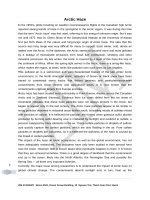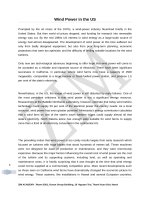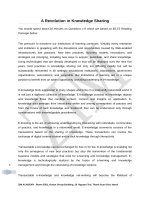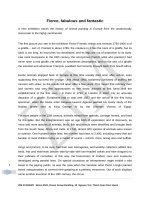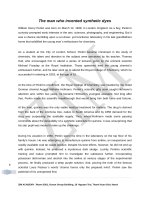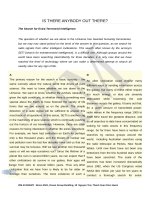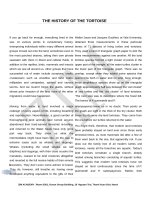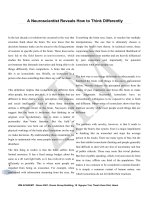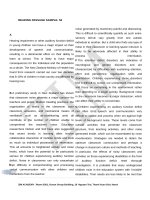IELTS academic reading sample 132 what is a port city
Bạn đang xem bản rút gọn của tài liệu. Xem và tải ngay bản đầy đủ của tài liệu tại đây (71.06 KB, 5 trang )
You should spend about 20 minutes on Questions 27-40 which are based on Reading
Passage 132 on the following pages.
Questions 1-4
Reading Passage has seven paragraphs A-G.
From the list of headings below choose the most suitable headings for paragraphs B-E.
Write the appropriate numbers (i-viii)
NB There are more headings than paragraphs, so you will not use them all.
Example
Answer
Paragraph A
vii
List of Headings
i A truly international environment
ii Once a port city, always a port city
iii Good ports make huge profits
iv How the port changes a city's infrastructure
v Reasons
for the decline of ports
vi Relative significance of trade and service industry
vii Ports and harbours
viii The demands of the oil industry
1 Paragraph B
2 Paragraph C
3 Paragraph D
4 Paragraph E
What is a port city?
The port city provides a fascinating and rich understanding of the movement of people and
1
goods around the world. We understand a port as a centre of land-sea exchange, and as a
major source of livelihood and a major force for cultural mixing. But do ports all produce a
range of common urban characteristics which justify classifying port cities together under a
ZIM ACADEMY | Room 2501, Ocean Group Building, 19 Nguyen Trai, Thanh Xuan Dist, Hanoi
single generic label? Do they have enough in common to warrant distinguishing them from
other kinds of cities?
A A port must be distinguished from a harbour. They are two very different things. Most
ports have poor harbours, and many fine harbours see few ships. Harbour is a physical
concept, a shelter for ships; port is an economic concept, a centre of land-sea exchange
which requires good access to a hinterland even more than a sea-linked foreland. It is
landward access, which is productive of goods for export and which demands imports, that is
critical. Poor harbours can be improved with breakwaters and dredging if there is a demand
for a port. Madras and Colombo are examples of harbours expensively improved by
enlarging, dredging and building breakwaters.
B Port cities become industrial, financial and service centres and political capitals because
of their water connections and the urban concentration which arises there and later draws to
it railways, highways and air routes. Water transport means cheap access, the chief basis of
all port cities. Many of the world's biggest cities, for example, London, New York, Shanghai,
Istanbul, Buenos Aires, Tokyo, Jakarta, Calcutta, Philadelphia and San Francisco began as
ports - that is, with land-sea exchange as their major function - but they have since grown
disproportionately in other respects so that their port functions are no longer dominant. They
remain different kinds of places from non-port cities and their port functions account for that
difference.
C Port functions, more than anything else, make a city cosmopolitan. A port city is open to
the world. In it races, cultures, and ideas, as well as goods from a variety of places, jostle,
mix and enrich each other and the life of the city. The smell of the sea and the harbour, the
sound of boat whistles or the moving tides are symbols of their multiple links with a wide
world, samples ofwhich are present in microcosm within their own urban areas.
D Sea ports have been transformed by the advent of powered vessels, whose size and
draught have increased. Many formerly important ports have become economically and
physically less accessible as a result. By-passed by most of their former enriching flow of
1
exchange, they have become cultural and economic backwaters or have acquired the
character of museums of the past. Examples of these are Charleston, Salem, Bristol,
Plymouth, Surat, Galle, Melaka, Soochow, and a long list of earlier prominent port cities in
Southeast Asia, Africa and Latin America.
ZIM ACADEMY | Room 2501, Ocean Group Building, 19 Nguyen Trai, Thanh Xuan Dist, Hanoi
E Much domestic port trade has not been recorded. What evidence we have sug3ests that
domestic trade was greater at all periods than external trade. Shanghai, for example, did
most of its trade with other Chinese ports and inland cities. Calcutta traded mainly with other
parts of India and so on. Most of any city's population is engaged in providing goods and
services for the city itself. Trade outside the city is its basic function. But each basic worker
requires food, housing, clothing and other such services. Estimates of the ratio of basic to
service workers range from 1:4 to 1:8.
F No city can be simply a port but must be involved in a variety of other activities. The port
function of the city draws to it raw materials and distributes them in many other forms. Ports
take advantage of the need for breaking up the bulk material where water and land transport
meet and where loading and unloading costs can be minimised by refining raw materials or
turning them into finished goods. The major examples here are oil refining and ore refining,
which are commonly located at ports. It is not easy to draw a line around what is and is not a
port function. All ports handle, unload, sort, alter, process, repack, and reship most of what
they receive. A city may still be regarded as a port city when it becomes involved in a great
range of functions not immediately involved with ships or docks.
G Cities which began as ports retain the chief commercial and administrative centre of the
city close to the waterfront. The centre of New York is in lower Manhattan between two river
mouths, the City of London is on the Thames, Shanghai along the Bund. This proximity to
water is also true of Boston, Philadelphia, Bombay, Calcutta, Madras, Singapore, Bangkok,
Hong Kong and Yokohama, where the commercial, financial, and administrative centres are
still grouped around their harbours even though each city has expanded into a metropolis.
Even a casual visitor cannot mistake them as anything but port cities.
Questions 5-8
Look at the following descriptions of some port cities mentioned in Reading Passage
Match the pairs of cities (A-H) listed below with the descriptions.
NB There are more pairs of port cities than descriptions, so you will not use them all.
1
5 required considerable harbour development
6 began as ports but other facilities later dominated
7 lost their prominence when large ships could not be accommodated
ZIM ACADEMY | Room 2501, Ocean Group Building, 19 Nguyen Trai, Thanh Xuan Dist, Hanoi
8 maintain their business centres near the port waterfront
A Bombay and Buenos Aires
B Hong Kong and Salem
C Istanbul and Jakarta
D Madras and Colombo
E New York and Bristol
F Plymouth and Melaka
G Singapore and Yokohama
H Surat and London
Questions 9-14
Do the following statements agree with the information given in Reading Passage?
Write:
YES if the statement agrees with the information
NO if the statement contradicts the information
NOT GIVEN if there is no information on this in the passage
9 Cities cease to be port cities when other functions dominate.
10 In the past, many port cities did more trade within their own country than with overseas
ports.
11 Most people in a port city are engaged in international trade and finance.
12 Ports attract many subsidiary and independent industries.
13 Ports have to establish a common language of trade.
14 Ports often have river connections.
1
ZIM ACADEMY | Room 2501, Ocean Group Building, 19 Nguyen Trai, Thanh Xuan Dist, Hanoi
Answer:
1 ii
2i
3v
4 vi
5D
6C
7F
8G
9 NO
10 YES
11 NO
12 YES
13 NOT GIVEN
14 YES
1
ZIM ACADEMY | Room 2501, Ocean Group Building, 19 Nguyen Trai, Thanh Xuan Dist, Hanoi
